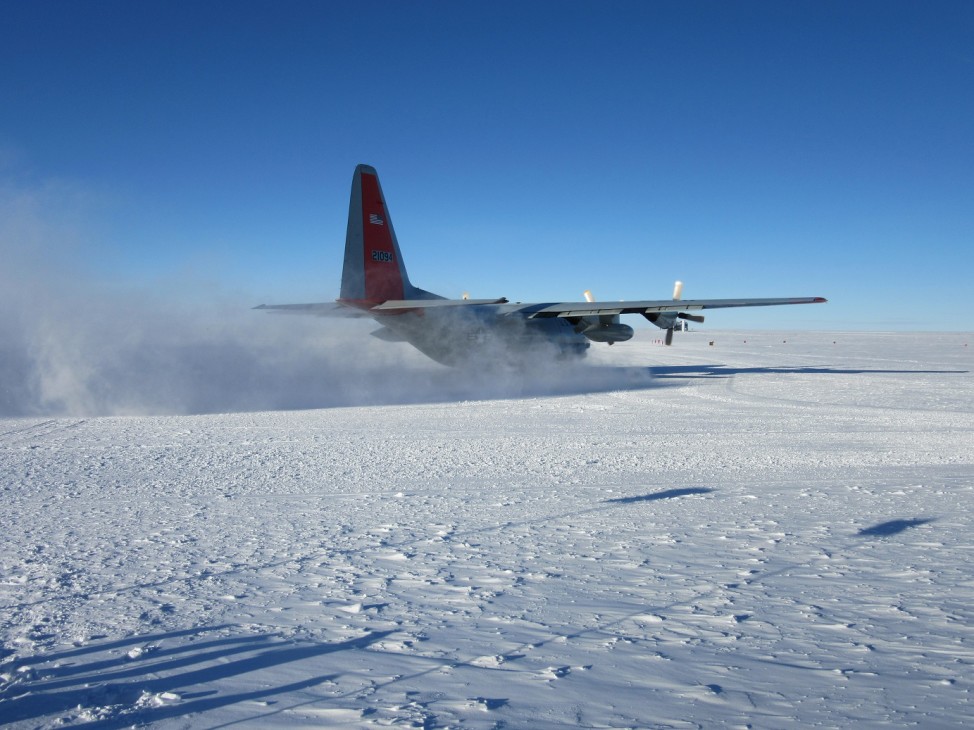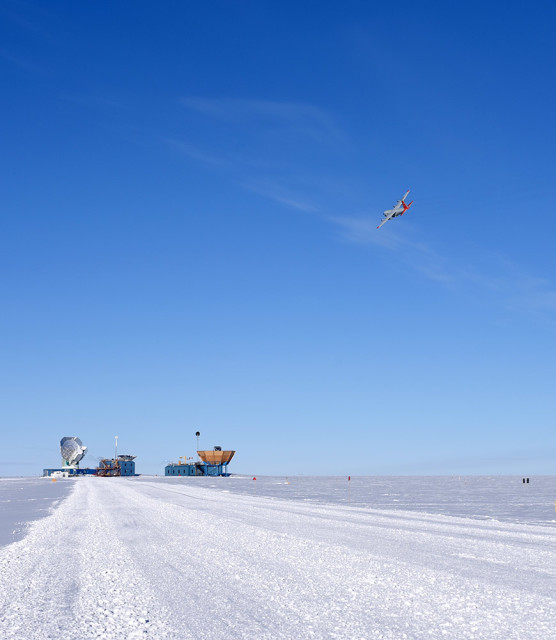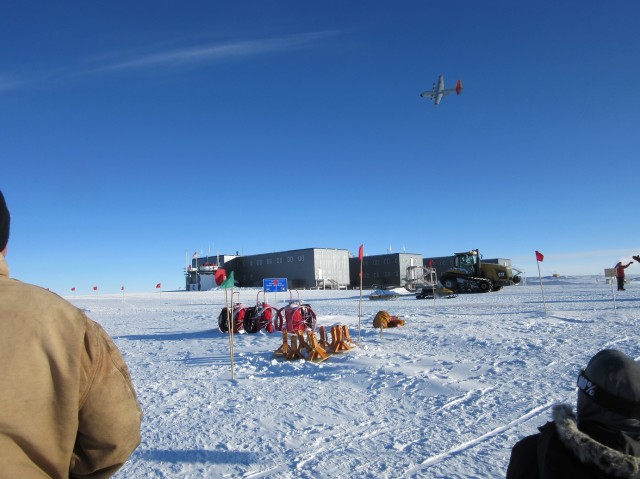
The season’s last LC-130 plane turns toward the runway. It will be eight months until another aircraft lands at the station. (Photo: Tim Ager)
It’s the season of long shadows. The ice cap is a maze of dark and light. The smallest protrusions of snow create as much shade as a beach umbrella at high noon. As I walk to work, I’m accompanied by a 20-foot projection of myself. It marches silently through a windswept landscape, numb to the cold, a perfect mime, shivering when I do.
SOUTH POLE JOURNAL
Refael Klein blogs about his year
working and living at the South Pole. Read his earlier posts here.
The sun sits 10 degrees above the horizon. Temperatures are getting colder. They will hit minus 50 Fahrenheit (minus 46 Celsius) any day, the cut-off for flight operations.
The last flight to Pole was on Monday. It landed for 20 minutes, just long enough for the last summer contractors and scientists to say their goodbyes, crack a few inside jokes, and still have enough time to walk casually to the aircraft and make themselves comfortable on board.
“Jovial” is how the scene outside was described to me. A 20-minute holiday with the majority of the station outside, giddy and talkative, like high school freshmen smoking their first cigarettes. For some, the last plane marks the beginning of winter. For others, it’s not until the sun sets.

South Pole Telescope and the other Dark Sector Labs were the last buildings the plane flew over. The plane did not cross into the the Clean Air Sector, which is restricted to flight operations. (Photo: Amy Lowitz)
Perhaps this time of year is best described as autumn? When orange light washes over everything and there are no ETAs (estimated time of arrival) or ETDs (estimated time of departure) listed on the station’s intranet.
I was on the roof of the Atmospheric Research Observatory (ARO), checking the orientation of our solar equipment, when the plane landed.
This time of year, with the sun setting as quick as it is, we have to adjust the azimuth angle of our roof-top instruments daily so they remain in line with the sun and continue to collect accurate data. Since we can only collect solar data when then sun is up (six months a year), it’s particularly important that we keep things in good working order.
The plane took off in a cloud of exhaust and blowing snow. It sped down the 6,000-foot ice runway, engines booming, gradually lifting into the air — ever so slowly easing itself off the ground as if it were probing the atmosphere for some unknown danger, before all of a sudden committing to its station and climbing steeply into the cloudless sky.
It was the size of my hand, then my palm, then my index finger. The plane grew more distant every second, and the landscape grew quiet again.
Then, unexpectedly, when it was at a distance where I could easily squish it between my index finger and thumb, the plane turned. It banked sharply to the left and descended steeply, speeding towards the station.

After taking off, the plane unexpectedly turns back toward the station. It circles the South Pole and then heads back towards McMurdo Station in Antarctica. (Photo: Tim Ager)
It was not in line with the runway. As the aircraft drew closer, the engines out-screamed the wind. The plane continued to dive. The engines out-screamed the clutter in my mind and then, 500 feet off the ground, directly over the station, the plane banked again, tipping a wing before turning back towards the Ross Sea.
A dramatic goodbye from the flight crew. The aircraft commander must have said, “Let’s give these Polies a bit of a thrill, something to talk about over dinner,” before pushing the sticks forward and bringing the plane around and down.
Back inside ARO, it was only me and the hum of our instruments. I finished my afternoon checks and began responding to a few emails while intermittently working on a monthly report for the National Science Foundation.
My back became stiff from sitting so I took a break. I boiled water, made some mint tea and stepped outside onto our first-floor deck. The plane was gone and the wind was blowing snow across the plateau in long wispy waves.
There are only 50 of us on station now and, for the first time in three months, the 50 of us are all alone.
Look for Refael Klein’s weekly blogs from the South Pole here on Science World. You can read his previous posts here.





















Rafael,
We have been following your stories from the pole, post by post. Please keep up your reports as you “journey” through the winter months. Thank you for sharing with us a glimpse of living as you are in this most interesting place.
Kindest Regards,
M
You are so courageous. Thank you for your service.
DL
Hello Rafael,
I hope this finds you doing well – the 20th of March. Can you see any direct sun now? Probably not. But it’s not quite winter yet!
Thanks for the fine article and images too.